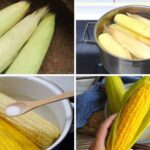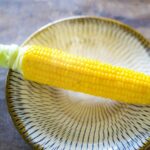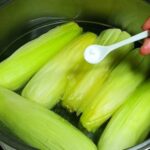Boiled corn is a simple dish, yet it captivates many with its natural sweetness, alluring aroma, and distinctive chewiness. However, many wonder why homemade boiled corn often turns out bland, tough, or dry, while corn sold by street vendors is sweet, soft, and chewy to the very last kernel.
Choosing the Right Type of Corn – The First Step to Success
The type of corn used for boiling directly impacts the flavor of the dish. According to street vendors, the secret lies in selecting young sweet corn, freshly harvested.
Young sweet corn typically has fresh green outer layers, evenly sized kernels, and a slightly soft feel. When gently pressed, it exudes a bit of milk. Boiling this type of corn results in natural sweetness and desirable chewiness, avoiding the mushiness or toughness of overripe corn. Avoid choosing field corn or hybrid industrial corn with large kernels as they tend to be dry and not as sweet.
Retaining the Husk and Silk – The Secret to Locking in Sweetness and Enhancing Aroma
A common mistake when boiling corn is removing all the husk and silk before cooking. In fact, leaving 2-3 layers of the young husks and the silk intact helps retain moisture during boiling, thus preserving the natural moisture and aroma of the corn.
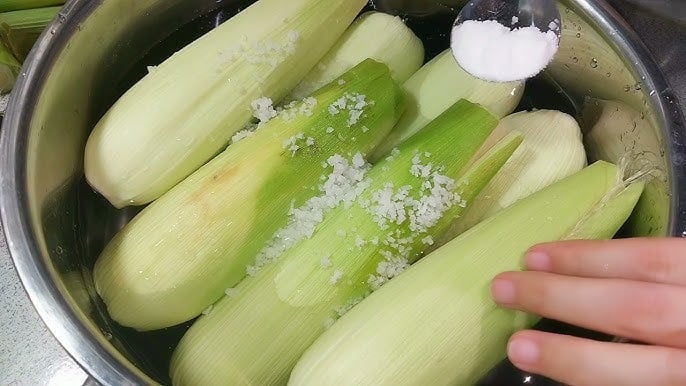
No Need for Sugar – A Pinch of Salt and a Handful of Rice Will Do
Many mistakenly believe that adding sugar or milk during boiling will enhance the sweetness of the corn. However, according to seasoned vendors, a pinch of salt and a handful of rice are all you need to make the corn soft, chewy, and flavorful.
The method is simple: place the corn in a pot with enough water to cover the ears, add about a teaspoon of salt and a tablespoon of rice. When boiled, the rice releases a small amount of starch, causing the corn broth to thicken slightly, which helps the corn retain its chewiness and absorb the sweetness better.
Salt not only seasons but also enhances the natural corn flavor, making the dish more savory without the need for sugar.
Boiling Time and the Trick of Steeping the Corn After Cooking
Once the water boils, turn the heat down and continue boiling for about 25-30 minutes to ensure the corn is thoroughly cooked from the inside out without being crunchy. Avoid boiling over high heat, as it may cause the corn to be undercooked on the inside.
When the corn is cooked, turn off the heat and let the corn remain in the pot for about 15 minutes. This allows the corn to absorb the flavors evenly and retain heat longer. This is the secret to keeping the boiled corn aromatic, preventing it from drying out, and staying warm longer than regular boiling.
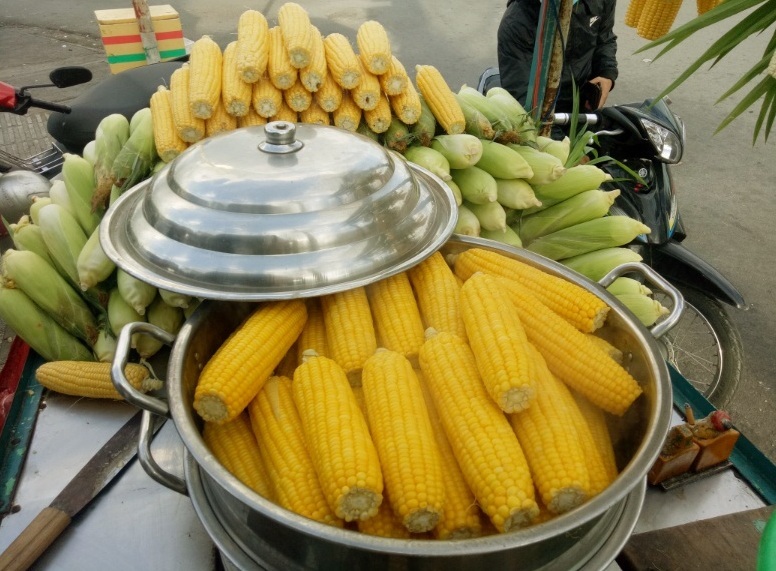
Without adding sugar or milk, and by following a few tips from long-time corn vendors, you can easily boil sweet, chewy, and aromatic corn at home. From choosing the right type of corn, retaining the husk, adding salt and rice, boiling for the right duration, and steeping the corn after cooking—these are all simple yet valuable secrets.
Give it a try and enjoy delicious street-style boiled corn with your family, a cost-effective, tasty, and nostalgic treat.
The Ultimate Guide to Cooking Corn: Discover the Secret to Perfectly Flavored Kernels
Introducing the art of boiling corn to perfection – a simple yet delicate process that eludes many. It’s time to elevate this familiar favorite with a twist of flavor and a touch of mastery. Say goodbye to bland and boring corn on the cob, and get ready to unlock a whole new world of taste sensations.
The Ultimate Breakfast Guide: 5 Delicious Alternatives to Pho, Especially Number 2!
“Noodles and pho have long been popular breakfast choices, but they aren’t always budget-friendly or convenient to prepare. There are plenty of other affordable and energy-packed breakfast options that won’t cost you more than 30,000 VND, offering a tasty and economical alternative to your morning bowl of noodles.”
The Ultimate Guide to Cooking Corn: A Chef’s Secret to Perfectly Tender and Sweet Corn
Professional chefs have revealed their secret to perfectly boiled corn on the cob: by adding just one simple step to the process, you can achieve a dish that is tender, sweet, and aromatic. With this extra step, your homemade corn will be just as delicious as what you’d find at your favorite restaurant.


























